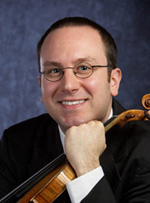by Mike Telin
The Italian experimentalist
Although Berio never composed a violin concerto, Corale (1981), is a more than suitable contribution to the canon by the composer. Scored for string orchestra and horns, Berio leaves his haunting Sequenza VIII intact and creates dialogues from within the orchestra that inventively support the solo line melodically, harmonically and rhythmically. Throughout the performance it was clear that David Bowlin has lived with this work for some time. Performing from memory, he made the many complicated technical passages, numerous double stops, and extended soft staccato lines sound effortless. His rich, dark and focused sound, combined with impeccable intonation, allowed the solo line to both sing above and blend with the orchestra. Conductor Timothy Weiss and his players performed their own complicated tutti and solo passages with ease. Above all, this performance achieved the essence of true chamber music.
Lament for Reja Vu (2012), by Ton Lopez, is an astonishingly captivating 8-minute work for flute, clarinet, violin, cello, piano, percussion, voice and laptop (video and real-time audio processing) that served as the perfect opening work for the concert. A takeoff on the notion of “Déja vu”, the work explores the feeling that something in the current moment will happen again in the future. A slow dissonant work of layered textures combined with the subtle use of electronic sound manipulations made the cavernous Warner Concert Hall feel like a space a quarter of its size. Musical lines were elegantly passed between players. Effects such as blowing into the instruments without using the mouthpiece or head joint, and rubbing together of hands created a meditative, mystical atmosphere. Vocalist Nicole Levesque produced pure tones even while vocalizing into her cupped hands. The music and nature-inspired video were perfectly in sync throughout.
alphabeta (2010) for piano four hands and two percussionists is a jarring work by Eric Wubbles consisting of three introductions and episodes that explore the intricate relationships between percussive sound and musical themes based on “song”, “speech” and “music” and was given a clean and unhurried performance by the excellent performers.
A trip to the dentist with his son inspired David Lang’s Sweet Air (2005). Lang writes, “My son experienced something — a drug — so comforting that it made him ignore all signs of unpleasantness. This seemed somehow musical to me.” Even though that drug was laughing gas, Lang’s composition is anything but laughable; rather, he brilliantly creates the sense of a quiet, floating dance (perhaps we should rethink our fears of the dentist’s office!) Scored for flute, oboe, clarinet, two violins, viola, cello, bass, piano and percussion, the work is somewhat electronic-sounding in nature. Tim Weiss led a rhythmically solid performance that brought out the work’s delightful harmonic shifts.
The final canonical hour of the Catholic Church served as Christopher Rouse’s inspiration for his 1996 composition, Compline. Composed in four sections and written for flute, clarinet, harp, two violins, viola and cello, the work is a set of variations in four continuous movements. The opening driving rhythm in the strings accompanied by flourishing wind passages moved into a gentle melodic duet for flute and harp. Following the fast third section the work fully begins to sound like its inspiration during the meditative final section, ending with the sounds of church bells fading into the distance. This was a performance of musical distinction. The players performed their individual parts with panache and together the ensemble sounded refined.
Published on ClevelandClassical.com December 11, 2012
Click here for a printable version of this article.



